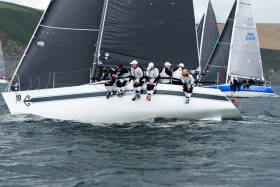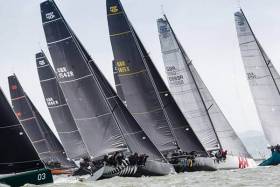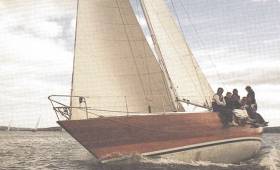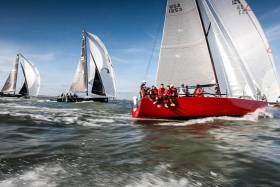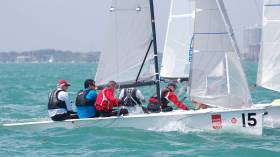Displaying items by tag: Anthony O'Leary
Reviewing Half–Ton Sailing: The Classic Cup in Kinsale & a Sailors Poll to Decide the Future
Mark Mansfield, tactician on The Big Picture, fourth overall at August's Euro Car Parks Half Ton Classic Cup 2017, reviews progress in the Class and the Kinsale Yacht Club event.
Having done the last two versions of this event I feel I have a decent level of knowledge to comment on the racing and the classes progression. Firstly well done to the organisers for staging a great event at Kinsale Yacht Club and well done to the Principal Race Officer Anthony O'Leary for running it so well. Finally, well done to Phil Plumtree and the Swuzzlebubble team for winning the regatta with a race to spare. This is the third win for Swuzzlebubble in three events, each with a different owner. More about this later.
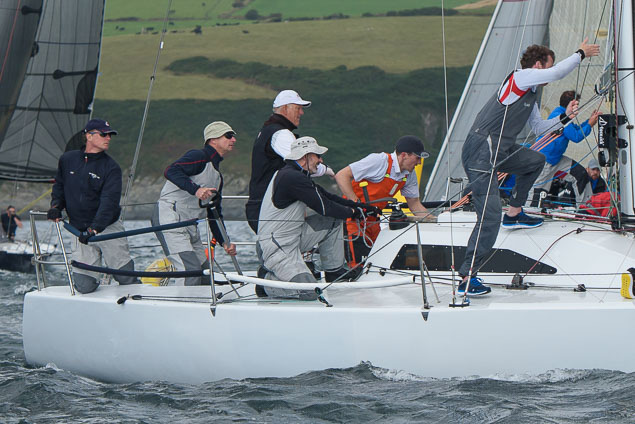 Mike and Richie Evans's The Big Picture, from Howth Yacht Club was fourth overall. Tactician and article author Mark Mansfield is wearing the white cap Photo: Bob Bateman
Mike and Richie Evans's The Big Picture, from Howth Yacht Club was fourth overall. Tactician and article author Mark Mansfield is wearing the white cap Photo: Bob Bateman
Day One—Nigel Biggs' new Checkmate XV111 just led from Paul Pullen's Miss Whiplash on countback. Swuzzlebubble lay one point back and Mike and Richie Evans,The Big Picture, lay a further point behind. David Cullen's Checkmate XV was a few points further back and it seemed likely that these five boats would be the feature boats in the event. All had professional sailors aboard and one of these boats had three professional sailors. Swuzzlebubble had an eighth place on this day which she would eventually discard but it was clear that she would be the one to watch as she was the top rating boat by some margin and was using that extra speed to get out in front allowing her to sail her own race.
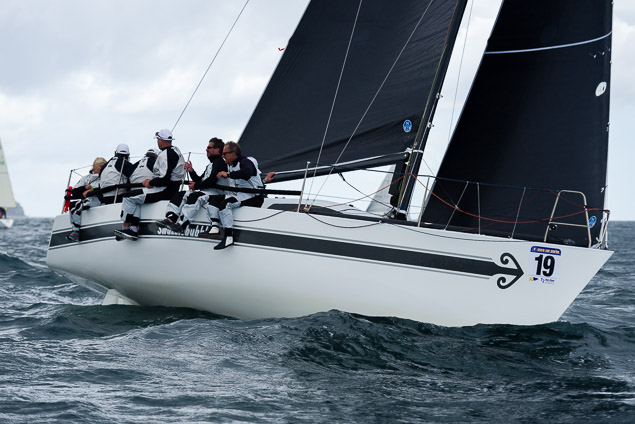 Phil Plumtree's Swuzzlebubble had an eighth place on day one but it was clear that she would be the one to watch as she was the top rating boat by some margin Photo: Bob Bateman
Phil Plumtree's Swuzzlebubble had an eighth place on day one but it was clear that she would be the one to watch as she was the top rating boat by some margin Photo: Bob Bateman
Day Two—Strong Southerly winds were forecasted for the following few days and so the organisers took the decision to delay the coastal race until later in the week and use day two to get in as many short WL races as possible. In the end four good races were sailed in moderate to fresh testing conditions. Swuzzlebubble counted two wins and two second places to shoot into a large lead over David Cullen's Checkmate who also scored two firsts. One point back was Checkmate XVIII and The Big Picture lay in fourth, a few points back. Big loser of the Day was Paul Pullen's Miss Whiplash who had four very average results and fell out of the running. It was now clear that the first four boats (Swuzzlebubble, Checkmate XV, Checkmate XVIII and the Big Picture) were pulling well clear of the pack and the winner would be from this group. Occasionally, other boats such as Paul Wayte's beautiful newly optimised Headhunter, Johnny Swan's Harmony and Philippe Pilatte's General Tapioca would come to the fore, but it was the first four that generally filled the top three results in each race and were pulling well clear.
 Paul Pullen's Miss Whiplash had four very average results on day two and fell out of the running Photo: Bob Bateman
Paul Pullen's Miss Whiplash had four very average results on day two and fell out of the running Photo: Bob Bateman
Day Three—Wednesday was postponed due to excess wind and many enjoyed a long lunch in Kinsale's Fishy Fishy restaurant accompanied by some very nice wines.
Day Four—Strong Southerly winds greeted the competitors and three races were planned including the none–discard coastal race. Swuzzlebubble took a first and a second in the earlier Windward Leeward races to extend her lead and the two closest followers, the two Checkmates each counted a poorish race to allow Swuzzlebubble be on the cusp of winning the regatta outright if she had a decent last coastal race. The Big Picture had consistent top results to lie in fourth. The final race of the day, the coastal race, ended in Swuzzlebubble taking a fifth, though a relatively poor result for her, it was enough to ensure Swuzzlebubble could not now be caught and did not need to sail the final race on the Friday. 1.5 points now separated the Two Checkmates with Dave Cullen in the marginal lead. Big Picture finished the Coastal race in second place and lay in fourth overall and could neither fall to fifth in the last race on Friday, nor get up to third. There was then a large points gap to General Tapioca and Headhunter.
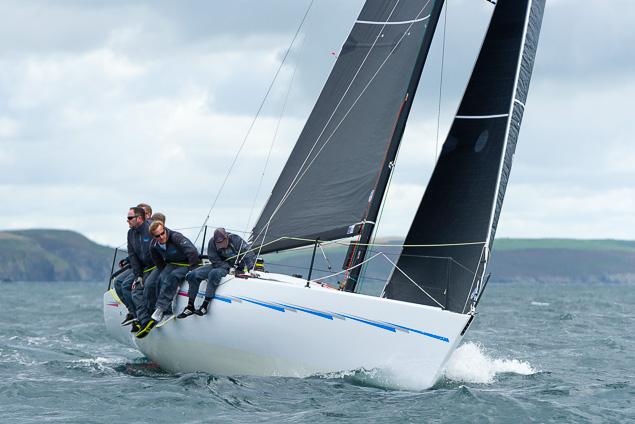 Only 1.5 points separated the two Checkmates with Dave Cullen's Checkmate XV (below) in the marginal lead. Photos Bob Bateman
Only 1.5 points separated the two Checkmates with Dave Cullen's Checkmate XV (below) in the marginal lead. Photos Bob Bateman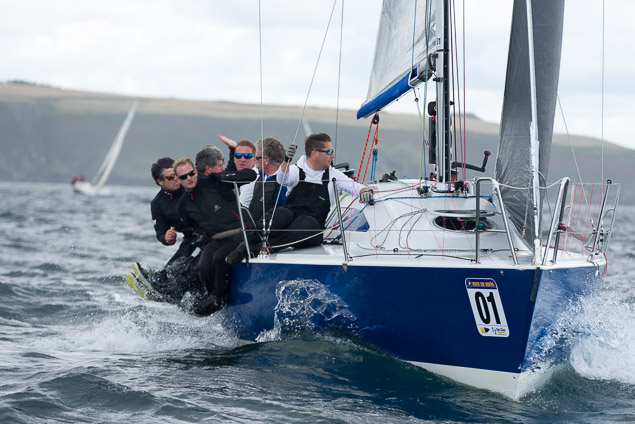
A successful Class dinner was held in Actons Hotel on Thursday night which went on late into the night, for some.
Day Five—Swuzzlebubble decided not to sail on the Friday. First and fourth places were already finalised (Swuzzlebubble and The Big Picture). Nigel Biggs needed to finish ahead of Dave Cullen and have a boat between them to finish in second overall. 17 to 20 knots greeted the fleet and PRO O'Leary signalled an around the buoys race consisting of two rounds and a finish off Charles Fort in Kinsale. Nigel Biggs got the best of the start and was ahead most of the race. However, Dave Cullen was in a bunch close behind that included the Big Picture. By the last mark Nigel Biggs rounded in the lead, followed by three other boats flowed by Big Picture with Checkmate XV behind her. Big Picture pulled through to second and Checkmate XV to third across the line. Big Picture with her lower handicap had a chance to snatch the win and deny Checkmate XVIII second overall but fell short by nine seconds and so the race finished with Checkmate XVIII winning followed by The Big Picture, followed by Checkmate XV, thus giving second overall to Nigel Biggs and Third overall to David Cullen. Fourth overall went to the Big Picture, fifth to General Tapioca and sixth to Miss Whiplash.
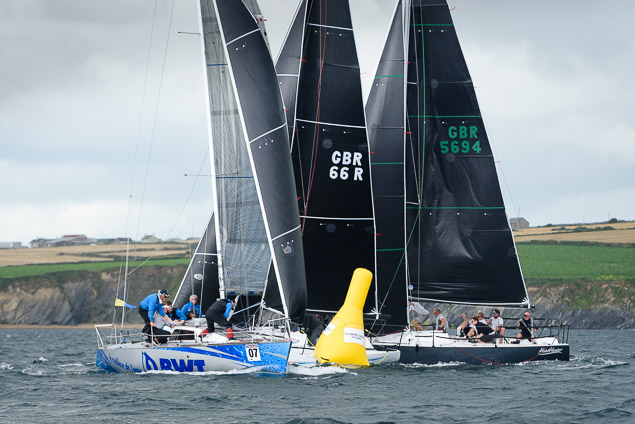 Half Ton racing is excellent, very close. The camaraderie within the class is also very strong
Half Ton racing is excellent, very close. The camaraderie within the class is also very strong
Progression of the class – Three newly optimised boats were among the 21 entries this year. The larger fleets of Half–Tonners are based in France, the UK and Belgium and if the event were in one of these locations it is likely entries would be closer to 30. During the regatta an agm was held to discuss some important points that appear to be affecting the class. These were;
1 Should the class limit the number of professionals on each boat
2 Should the class, like they do in the Quarter ton Class, put an upper handicap limit on yachts taking part.
3 Should the class allow asymmetrical spinnakers.
1—Limiting professionals. A poll of Half Ton members will likely be done to either limit the professionals on each boat to either one or Two. It was felt generally that professionals help to coach the crew and generally are good for the class, but too many and the professionals can effectively sail the boat themselves, thus little improvement happens when the pros depart.
2—Limiting the upper Handicap limit. Swuzzlebubble has been a problem child in this class since Peter Morton did a no–expenses spared restoration of this very long half tonner. This included a taller, ultra high Modulus Carbon Rig with more sail, a deeper keel and other top mods. This led to her being approx. 25–points higher rating than most. Consequently she can go for a conservative start, sail for a few minutes and then her speed allows her to cross the fleet and sail the remainder of the race without other interference. The remainder of the fleet are close on rating and end up very close to each other at all marks, taking wind on downwinds, etc. This is costing the bulk of the fleet a minute or more per race, and often that is about the margin that Swuzzlebubble wins by. She is being well sailed, but she has a great advantage. In the Quarter ton class they stopped this issue early and now most quarter tonners are within 10 points of rating of each other. It is being suggested that an upper limit of .965 be introduced. Swuzzlebubble would be able to get to this by reducing sail area and adding some weight which would lessen the advantage she currently enjoys, especially in light to medium conditions. A proposed poll of the class is being organised on this.
3—Allowing Asymmetric sails. This appeared not to be so straight forward. Some owners already have them (but can't use them at the Half Ton Cup). Allowing them might mean owners have to buy one or two asymmetric kites, perhaps add a sprit and in the end may not even use them at a Half Ton cup. Others would prefer to stay without them as most of the racing is windward leeward anyway. This will also be balloted.
Summary – Having sailed four Quarter Ton Cups and now two Half Ton cups, The Half Ton class is now easily as competitive as the quarter tonners. The racing is excellent, very close. The camaraderie within the class is very strong. I can see more restorations being done in this class and numbers rising for their Half Ton Cups. Next years event will be in Nieuwpoort in Belgium in mid–August and I suspect that there may be up to 30–boats will arrive for that. The inaugural IRC World Championships is being held just up the road in The Hague in Holland a month before the Half Ton worlds so there are many half–tonners considering doing that as well as a warm up event. The boats are of a size that they can, if required, be transported by water, though most will trail behind jeeps.
Mark Mansfield is a four–time Irish Olympian, a helmsman in the Star Class from 1992–2004. He is a World Sailing 'Group 3' Sailor.
Peter Morton's Carkeek 40+ 'Girls on Film' Wins 2016 One Ton Cup
It was fifth time lucky for Morty, but the wait is now over. Peter Morton's Carkeek 40+ Girls on Film has won the 2016 One Ton Cup. The Cowes based team that included Ireland's Justin Slattery were worthy winners having scored no worse than a fourth in nine races. Peter Morton has come second in the One Ton Cup on two occasions and the attempts to win the prestigious trophy span over three generations.
Royal Cork's Antx skippered by Anthony O'Leary finished eighth in the 13–boat fleet
“It has been unfinished business.” smiled Peter Morton, rinsed in champagne. “The team on Girls on Film have ben absolutely fabulous. I would also like to thank the Royal Southern Yacht Club and Principal Race Officer , Stuart Childerley and his team for outstanding race management. Also Rob Greenhalgh for coming up with the idea of the FAST40+ Class and putting it together. For those of you that haven't won, I would say just be patient, your time will come.”
Girls on Film: Peter Morton, Darren Marston, Phil Pafford, Nat Ives, Justin Slattery, Ash Curtis, Toby Mumford, Duncan Yeabsley, Nick Butt, Dirk de Ridder and Dave Lenz.
Alex Mills at the helm of Ker40+ Invictus was runner-up, Invictus tactician and FAST40+ Class President, Robert Greenhalgh, congratulated Peter Morton and the Girls on Film crew. “At the beginning of the season, we didn't really know what to expect. The class has grown far quicker than we expected and it is continuing to attract more owners and sailors. The FAST40+ is an ideal boat for the Solent and during the season, the racing has got tighter and tighter. The One Ton Cup is our biggest event and to have nine boats make the podium just shows how competitive the FAST40+ Class is.”
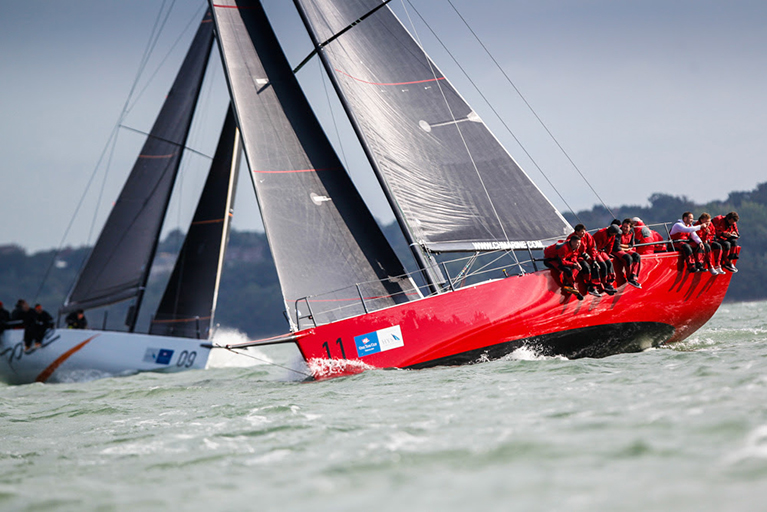 Anthony O'Leary's Antix competing in the One Ton Cup. Photo: Paul Wyeth
Anthony O'Leary's Antix competing in the One Ton Cup. Photo: Paul Wyeth
On the final day of racing, Mike Bartholomew's South African GP42 Tokoloshe was the winner of the penultimate race of the regatta and Bill Coates Texan Ker 43 Otra Vez finished the One Ton Cup in style winning the final race.
The One Ton Cup owned by the Cercle de la Voile de Paris, presented by Hamble Yacht Services and organised by the Royal Southern Yacht Club, took place between 16-18th September in the Solent, UK. Nine races completed with a mixture of windward-leeward and weighted points factor longer races.
Full Results from the One Ton Cup here
Irish Endorsement for Fast 40s 'One Ton Cup'
The FAST40+ Class announcement of a One Ton Cup (OTC) event in September has been given the thumbs up from Irish skipper Anthony O'Leary who competes in the new class in the Royal Cork Yacht Club entry, Antix.
The first Cup event will by hosted by the Royal Southern Yacht Club, Hamble between 16-18th September 2016. O'Leary hopes the Cup could even come to Ireland at some point in the future.
'It is a fantastic move by the Fast 40+ Class Assoc. It is most appropriate that the OTC be awarded to the leading team in this class', O'Leary told Afloat.ie 'It will make what is already a most competitive class all the more challenging', he added.
The ONE TON CUP is steeped in history and reputation in the world of yacht racing. Created by the Cercle de la Voile de Paris (CVP – Paris Yacht Club) back in 1899 and widely recognised as a masterpiece of art nouveau style, initially raced for in regattas between one tonner sailing yachts. The trophy itself was designed in 1897 by the jeweler Robert Linzeler and was made by Bratiau in 1898. It is made of solid silver and weighs 10 kgs standing at 57cm high and 58cm wide.
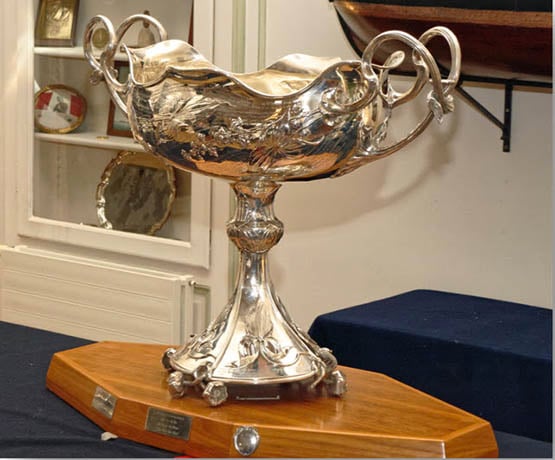
The One Ton Cup has been raced for in International 6 Metre yachts, and for a short time on 6.5m SIs. In 1965 this trophy moved into the world of ocean racing, and from there into the RORC and IOR ruled racing circuits. Most recently, in 1999, the Cup was presented to the Corel 45 Class. Winners of the Cup include many legends in our sport such as Syd Fischer, Royal Cork's Harold Cudmore, Henrik Soderlund, King Harald V of Norway, Paul Cayard and Russell Coutts.
The hosting of this event and the realisation of getting the magnificent One Ton Cup trophy to the UK has been made possible through the support of a number of organisations and individuals, especially Cercle de la Voile de Paris for recognizing the profile of this growing class and agreeing that this is an event worthy of such a trophy, and Hamble Yacht Services who will be the Presenting Partner for the event.
Francois Laborde (President of the Cercle de la Voile de Paris – Paris Yacht Club), commented:
"We are excited to announce this partnership with the Fast40+ Class for the 2016 edition of the One Ton Cup. The boats have amazing performance characteristics, are fun to race, and are attracting top sailing talents. Those characteristics are exactly in line with the tradition and objectives of our Cup."
The FAST40+ CLASS represents the modern day One Ton race yacht, light displacement race boats, with IRC TCCs of between 1.210 and 1.270. This narrow band of high performance race yachts is designed to deliver fast, close inshore racing.
Robert Greenhalgh, Class President, came up with the concept in 2014 and, after engaging the commitment of a number of interested owners and sailors, this year the class will host a fleet of 14 race boats competing at the highest level over a circuit of 5 UK based events. The boats hail from 7 countries – UK, Ireland, Scotland, USA, South Africa, New Zealand and Germany – and the fleet is growing quickly in competitor numbers and profile.
Robert commented, “The owners of this exciting class take their racing seriously – we are already experiencing incredibly close and exciting inshore racing and it seems to be ticking all the boxes. To secure such a significant trophy as the One Ton Cup to be our showcase trophy for 2016 is sure to add pressure and focus to the racing – this is THE trophy to win this year.”
Traditionally the One Ton Cup regattas consisted of inshore racing, a coastal race and a proper offshore race. Reflecting the changing times and demands of race circuits today, the Fast40+ One Ton Cup will be raced between 16th and 18th September hosted by the Royal Southern Yacht Club and will consist of 8 scheduled races over the 3 days with event rankings for each boat being multiplied by 2 for the overall 2016 Race circuit results. The courses will be a mixture of windward – leeward and coastal courses sailed in Solent Waters, each race lasting between 45-180 minutes.
Peter Morton , owner of Girls on Film, added his thoughts, “I have seen a new lease of life injected back into the Solent racing scene through the Fast40+ Class since 2015. Close racing, passionate owners and competitors who reveling in the competitive scene, a good onshore social scene and all run by a professional organisation – and now with the addition of this slice of history to win, what more could we want!”
Archie O'Leary 1929–2016
In a well-lived life in Cork in which he was exuberantly involved in several sports and long active in a pioneering role in business, he was known to everyone as Archie O’Leary. Yet properly speaking he was Arthur O’Leary, sharing his name with the historic and heroic figure of Art O’Leary (1746-1773). But this modern Arthur O’Leary, who has now gone from among us at the age of 86, was of more than enough significance to merit his own distinctive name.
It was as Archie O’Leary that he played rugby for Ireland, rising through the ranks of Cork Con (where he was Captain) and Munster, to win three caps in the national side in 1952. It was Mr & Mrs Archie O’Leary who became well known in racing circles, their most famous and successful horse being Florida Pearl. And it was as Archie O’Leary that he served as Admiral of the Royal Cork Yacht Club from 1977 to 1980, crowning a very long sailing career which was to continue until the1990s, when he changed his perspective afloat by moving into a Nelson 42 powercruiser, the kind of motoryacht which was designed with senior sailing people in mind.
His energies afloat and on the sports field were matched by his energy in business – in 1961 he founded the O’Leary Insurance Group which today, under the Chairmanship of his son Anthony, has expanded to become an all-Ireland force in the industry. The strength of family values within the O’Leary clan is also reflected by the fact that Anthony took on the demanding role of Admiral RCYC at a young age in 2000, just twenty years after his father had headed the club. And Anthony has of course carved his own distinctive and successful career in sailing (he’s currently the Irish Champion Helmsman), while his own sons in turn – Archie’s grandsons – include Olympic sailor Peter, Student World Sailing Champion Nicholas, and Irish Student Champion Robert.
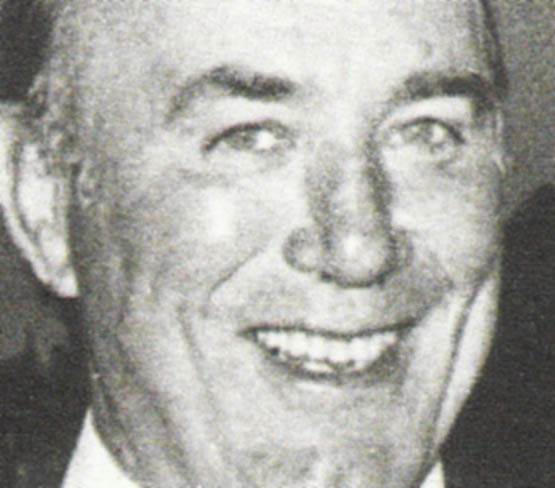
Archie O’Leary, Admiral RCYC 1977 to 1980
Today, we honour the memory of the Patriarch of this remarkable family of sailing high achievers, for Archie O’Leary was an extremely successful owner-skipper in his own right. Like many of Cork sailing’s racing aristocracy, his first proper taste of the sport was with the National 18s. But by the early 1970s he found that offshore racers best suited his tastes, and he campaigned an S&S 34 for a couple of seasons, starting to build up friendships at home and abroad which well withstood the test of time.
By late 1973, the new blossoming of Cork sailing was becoming very apparent, and while the most active campaigner Hugh Coveney went for the peak challenge of the International One Ton Cup with the state-of-the-art one-off Ron Holland-designed, George & Killian Bushe-built 36ft Golden Apple, Archie O’Leary took a different tack by commissioning a new though standard Carter 37 from the board of Dick Carter. Carter had burst upon the scene in 1965 when his innovative 34-footer Rabbit won the Fastnet Race overall, and had subsequently won the One Ton Worlds with the Dutch-American owned Tina in 1966, Optimist of Germany in 1967 and 1968, and the Italian entry Ydra in 1973.
From today’s perspective, it is difficult to grasp the scale and enthusiasm of the One Ton Worlds at Torquay in 1974. Here were more than forty red hot boats around the 36ft mark from all over the world, and all competing absolutely level, sailed in many instances by Olympic-standard crews. Many were expensive purpose-built one-offs, yet there was also a small but significant group of production boats, tuned to the One Ton rating, which were expected to be little more than cannon fodder in a field of this standard.
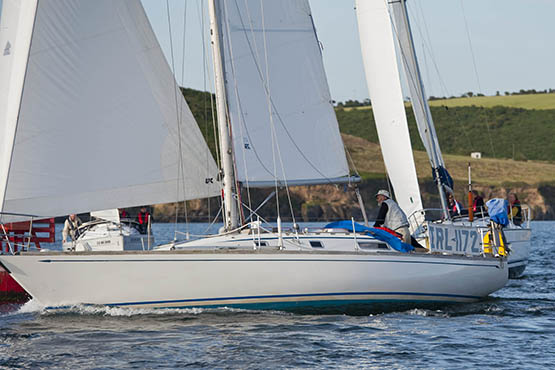
The first Irish Mist of 1974 was a standard Carter 37, and she was clear winner of the Production Boat prize at the One Ton Worlds that year
But Archie O’Leary’s standard Carter 37 Irish Mist was definitely not cannon fodder. With the young Anthony O’Leary now very much an active member of his father’s crew, Irish Mist was at the races, and then some. She won the Production Boat prize by a very clear margin, and placed tenth overall with an entire host of extremely hot one-offs astern of her.
As his sailing career progressed and developed, Archie O’Leary was to win many other major prizes, both offshore and on the championship circuit. But in later life there was no trophy he cherished more than the fine cup he’d been given in perpetuity for that Production Boat win at Torquay, for he reckoned that was purer sport than the competition he was soon to experience at the very sharpest end of international sailing.
Yet the pace was now inevitably set, and for 1975 the O’Learys commissioned a one-off Ron Holland Two Tonner, the 40ft Irish Mist II, built at Rochestown by George and Killian Bushe. This superboat really did have all the bells and whistles, complete with a Bergstrom Ridder hyper-light mast. She lived up to all her billings, winning the 1975 RORC Channel Race as a member of the Irish Admirals Cup team, in addition to many other podium places, while the following year she was overall winner of the RORC Irish Sea Race and was also top boat in the biggest regatta in Ireland that year, ISORA Week 1976 at Cork.
In the mid-1970s, the Irish Sea Offshore Racing Association was at its most numerous, and if they brought their Race Week to some venue, it guaranteed big turnouts. But ISORA had at least half a dozen and more locations to choose between – they mightn’t be back for another ten years. However, by this stage Archie O’Leary was rising through the officer ranks in the Royal Cork, and by the time he became Admiral in 1977, he’d realized that a more regular regatta week was essential for the good health of Crosshaven, and he’d plans in shape for what would become Cork Week, run on a biennial basis with the first one in 1978.
To make it all happen, he drew on firm friendships made through his years of active campaigning on the RORC and Celtic Sea programmes, and thus people like Chris Dunning from the Solent and Rob Davies from South Wales could be relied on to beat the drum for their friend Archie and his regatta in Cork, and this was to be the start of something big.
But in the best Cork traditions, while working busily in the administration of the rapidly-expanding Royal Cork YC, Admiral O’Leary continued as a very active sailor, moving on from the timber-built Irish Mist II to the glassfibre Swan 39 Irish Mist III, the production version of the fabulously successful Ron Holland-designed Regardless, and from there he went on to a Lightwave 395.
Although he was best noted for his national and international achievements, Archie O’Leary was never happier than when involved in the notably high standard of club racing against old friends at Crosshaven, when the finest traditions of the world’s oldest yacht club are given a contemporary twist.
In fact for decades – with his actively sailing family spreading onto three generations – Archie O’Leary was the very expression of the Cork sailing spirit. And even when he’d reduced the pace by changing to the Nelson powercruiser, his taste for a spot of sport afloat was undiminished. My most abiding recent memory of Archie O’Leary was of a time one Spring some years ago when his beloved Cork Constitution Rugby Club (of which he was President in 1973-74) had won through to the Irish club final, to be played at Lansdowne Road in Dublin. Archie noted that the weather pattern was settling down nicely, so he suggested to his regular shipmates that they should go in style to Dublin with the powercruiser, and use her as a houseboat for the weekend of the match.
Then as the weekend approached, a wondrous and unseasonal calm settled over all Ireland. So what did the O’Leary crew do? They came to Dublin from the north. Bound for the rugby match, they left Cork heading west, streaked up the Atlantic seaboard, roared along the north coast, zoomed down the Irish Sea to take in the match, and then went on home by sea as though this was all part of a normal weekend away for rugby fans. That was how Archie O’Leary approached life. Our heartfelt condolences go to his family and very many friends.
WMN
It has been confirmed by the Irish Cruiser-Racing Association (ICRA) that it’s extremely unlikely that Ireland will be mounting a defence in July 2016 of the RORC Commodore’s Cup, which we so convincingly won in 2014 with the team of Catapult, Antix and Quokka 8. Apparently the defence has foundered on the difficulties of finding a person or group willing to take on the campaigning of a third boat which would be suitable to back up Anthony O’Leary’s 2014 Ker 40 Antix (ex-Catapult), and Michael Boyd’s new JPK 10.80. Michael Boyd and Anthony O’Leary had lined up a possible charter of Quokka 8 on a speculative (and expensive) retention fee in the hope that a team of optimal make-up could take shape, but no-one has proved willing to take up the costly full-charter option to make her the third boat. W M Nixon reflects on this unhappy follow-up to a good news story which helped lift Ireland out of the gloom of the recession in 2014.
The Commodore’s Cup 2016 as a Sail Training exercise? It’s one of the less crazy scenarios which is emerging from the conclusion that a realistic and highly-powered defence of Ireland’s 2014 win is simply not on the cards. The word is that the two front-line boats have been unable to find people with mega-resources and a crew willing to take up the third slot with Quokka, or possibly another boat altogether. Thus all bets are off.
To outsiders, it all sounds like a bit of the old hissy-fits, and more. Surely something could have been done? But those who have been in the midst of the Commodore’s Cup cauldron have some idea of both the stress involved (which is huge at the front of the fleet), and just how very much it is more important than ever to have a finely balanced team.
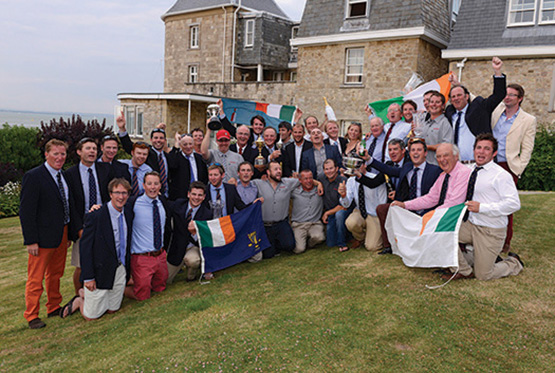
The big day – the Irish team park their tanks on the Royal Yacht Squadron lawn in Cowes after winning the Commodore’s Cup, July 2014
It all looked so easy once 2014’s win had been stitched up. But as the post-series review here on August 2nd 2014 revealed, the stresses and strains – particularly on Anthony O’Leary who did the heavy lifting in putting the team together and keeping the show on the road – were beyond most people’s imagining.
With hindsight now, it is easy to say that it was somewhere back towards Easter this year that the writing on the wall began to appear about how Ireland was going to have to opt out of the 2016 series. The new wave of Fast40+ boats on the Solent in the RORC Easter Challenge had been giving the already senior Antix a very hard time. If Anthony O’Leary and his crew were going to give of their best in campaigning their own boat in what is rapidly emerging as the hottest class in Europe, then they didn’t really need the distraction of rustling up a Commodore’s Cup team to add to their struggles.
For sure, back in 2014 the Commodore’s Cup was top billing. But the remorseless growth of the Fast 40s is making them the top show in town for 2016. They’d seven or eight of them in serious contention last year. At Easter, it was 10 and 11 boats, many of them barely out of the wrapping. In two weeks time, when they have their next major three day event on the Solent from May 20th to 22nd, we will be looking at a dozen and more boats so hot you could fry an egg on them.
Numbers like this, at this level of competition, inevitably attract the heavy hitters among owners and top professional sailors, providing a challenge which you either take head on, or opt out of altogether. For the amateur crew of Antix, it’s a case of take it or leave it. In taking it with full commitment to Fast40+ racing, they simply have to accept that they can’t overload themselves by the extra effort of running Commodore’s Cup involvement, though perhaps they could contemplate being in an Irish squad if by some miracle the perfect team package is put completely and exactly in place by some sort of offshore racing fairy godmother.
But you don’t get fairy godmothers in the rough tough world of offshore racing. The perfect dream package isn’t there, and it won’t be. So Antix and her crew of dedicated amateurs are going to be in the David and Goliath situation of throwing themselves totally into the fray of the Fast 40s, and we can only hope that the original David and Goliath scenario is replicated, for this is definitely the big boys’ game.
And yet, and yet……there’s no such thing as an inevitable outcome. Who knows what might emerge from the first proper gladiatorial confrontation of the Fast 40s in their newly confident expanded numbers? We may be saying this morning that an Irish defence is over and out. But surely it’s not beyond the realms of possibility that in the heady post-regatta atmosphere at the RORC’s Cowes base in a fortnight’s time, somebody might say: Why don’t we as a crew take a boat and join up with Antix and the new JPK 10.80 to race for Ireland?

The JPK 10.80 Courier du Leon wins the 2015 Rolex Fastnet Race
Stranger things have happened in putting Commodore’s Cup teams together in the past. In 2014, so speculative was the buildup that Anthony O’Leary admitted afterwards that until the American Ker 40 Catapult was actually unloaded from a Transatlantic ship on European soil, he wasn’t a hundred per cent convinced she was going to appear at all.
Yet ironically, there was Catapult on the quay as hoped for, after various dockside and clubhouse meetings and negotiations in Key West way back in January. But the whereabouts of the team’s third boat Quokka 8, which had been chartered by Michael Boyd and Niall Dowling, was now a matter for concern.
She’d been campaigning in the Caribbean through the winter, but had been scheduled to be shipped back in plenty of time for the start of the new RORC offshore season. But the ship she was aboard was re-routed, then re-routed again. She arrived back this side of the Atlantic barely in time for the team’s first get-together at Volvo Cork Week in July 2014. But then it all became sweetest fantasy, as Quokka won Volvo Cork Week overall, following which the Irish team won the Commodore’s Cup going away.

Quokka 8, overall winner of Volvo Cork Week 2014
So who knows what might just somehow develop. But meanwhile the critics are sharpening their knives, and there’s much muttering about it being disgraceful that Ireland doesn’t look like defending a trophy we were so pleased to win just two short years ago.
Thus a suggestion is floating around that ICRA should be prepared to allow just about any old team to go and join the scrap for the Commodore’s Cup 2016. Why not, they suggest, just allow three J/109s to go along to represent the Ould Sod, and give their crews a real taste of sailing at the sharp end?
Certainly the Commodore’s Cup as a Sail Training event has a distinct Quixotic appeal. But underneath the whole story is the reality that while in places like the Solent the top end of high-profile sailing is invariably dominated by professionals, within and around Ireland we don’t really do professional competitive sailing at all.
We’re compulsive and obsessive amateurs, and that’s the way we like it. If our sailing isn’t fitted in to cherished little slivers of free time carved out of the day job, then we don’t really think it’s genuine sport at all. Thus while it’s fine and dandy every so often to take on the Solent heavies and maybe just occasionally show them the way, we’d just as soon save our limited holiday time for a proper tilt at the West Cork Regattas or events like the ICRA Nationals, where we’re racing against people we know, and not shelling out money for exorbitant Cowes rentals. Like it or not, that’s the way we are.
Meanwhile, it’s rumoured that the 2018 Commodore’s Cup will be based of teams of just two boats each. Now they tell us…….But that’s not teams. That’s multiple doubles matches.
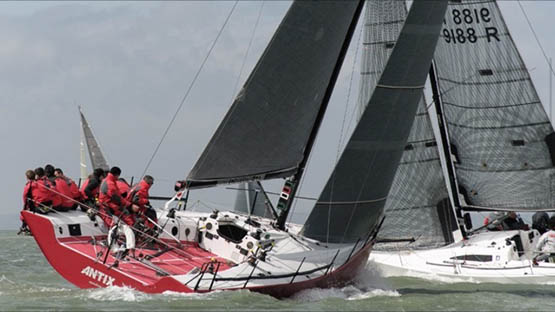
A demanding animal to sail. The tiller-steered Ker 40 Antix is not for the faint-hearted
Read also: ICRA Statement on 2016 Irish Commodore's Cup team
Royal Cork Viper Trio Eighth in Miami's Bacardi Sailing Week
Cork Harbour's Anthony and Robert O'Leary and Tom Durcan have finished in the top eight of the competitive Viper 640 Bacardi Sailing Week fleet. The overall result brings a successful conclusion to a week of racing in Miami, Florida where the Royal Cork YC trio also finished second in the EFG Winter Cup regatta the previous weekend. O'Leary was pipped for the overall EFG win by Lawrence and Luka Crispin and Hector Cisneros, a British entry that swept the Viper Miami week of sailing.
O'Leary counted six top ten results in the eight race Bacardi Cup, missing seventh place in the 29-boat fleet by just two points.
After turning in a dominating performance for the EFG Winter Cup, Crispin and crew controlled Bacardi Miami Sailing Week Regatta which was also the EFG Viper Pan-American Championship.
By placing well in two Pan-Am qualifiers (the NAs and the Winter Cup) Lawrence, Luka and Hector will also be taking home the Pan-Am Champs as they return to the UK and Stone Sailing Club.
The Viper 640 class is coming to Volvo Cork Week in July.
Meanwhile, for the week that's in it, we very much like the spinnaker on Trey Sheehans' J70 Bacardi Sailing entry from Put-in-Bay Yacht Club, Ohio.
J/70 at BACARDI Miami Sailing Week
Posted by IPHOTOJOURNALIST on Saturday, 12 March 2016
Royal Cork's O'Leary Retains All Ireland Title in Style
The defending All Ireland Sailing Champions Anthony O'Leary with crew Dan O'Grady and Cian Guilfoyle were winners again but this year by a clear margin of five points after two days of competition on Dublin Bay.
Counting two wins and two second places in the supplied J/80 sportsboat fleet, the Commodore's Cup champion from Royal Cork beat fellow Cork Harbour sailor Alex Barry of Monkstown Bay and Royal Cork who was runner up on 11 points. See full results sheet below.
Not only does today's give Royal Cork a one–two in the senior competition but the Munster club also won the Junior Helmsmans title a fortnight ago too.
Third today was Howth's ICRA representative Cillian Dickson on 12 points. The ISA event was hosted by the National Yacht Club.
'We definitely sailed better this year than last' O'Leary told reporters on coming ashore.
But O'Leary didn't have it all his own way early on. As the south-easterly breeze built at mid-day O'Leary led the first race but RS400 rep Barry stayed within striking distance and at the finish line the MBSC sailor took the advantage by a boat length, setting up a thrilling conclusion to the 2015 All Irelands.
Anthony O'Leary's sons Peter and Nicholas have also won the ISA championship a number of times (in both the 1720 and J/80 sportsboat classes) bringing the O'Leary family total to seven of the last ten championships.
 After a series of light air qualifiers on Saturday, Sunday brought more breeze for the eight finalists
After a series of light air qualifiers on Saturday, Sunday brought more breeze for the eight finalists

The start of race two – O'Leary (5) to leeward with a second or two to go
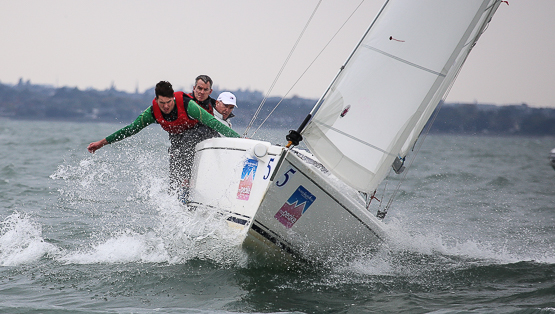
(Above) Anthony O'Leary with crew Dan O'Grady and Cian Guilfoyle in winning form in race two and (below) setting up for race three. Time between races was at a premium with competitors having only minutes to prepare in a rapid fire final.


Sailing with four up, Howth's ICRA representative Cillian Dickson was third overall. Diana Kissane (pictured above), crewing for Dickson was the only female in the top three crews. Diana will sail in the women's match racing grand final at the end of October.
 On the water judging was a feature of the All Ireland's on Dublin Bay
On the water judging was a feature of the All Ireland's on Dublin Bay
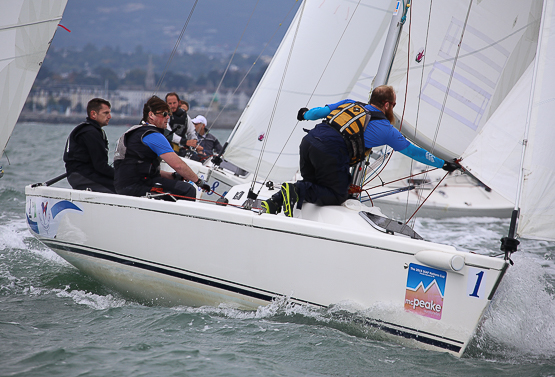 Roy Darrer from Waterford harbour SC was fourth
Roy Darrer from Waterford harbour SC was fourth
2015 ISA All Ireland Sailing Championships Results

Read also WM Nixon on why The Irish Championship Of Sailing Champions Is More Important Than We Might Think
2015 All Ireland photo gallery HERE
This weekend’s two-day All-Ireland Sailing Championship at the National Yacht Club in Dun Laoghaire, racing boats of the ISA J/80 SailFleet flotilla, is an easy target for facile criticism. Perhaps because it tries to do so much in the space of only two days racing, with just one type of boat and an entry of 15 class championship-winning helms, inevitably this means it will be seen by some as falling short of its high aspiration of providing a true Champion of Champions.
Yet it seldom fails to produce an absolute cracker of a final. Last year, current defending champion Anthony O’Leary of Cork, racing the J/80s in Howth and representing both ICRA Class 0 and the 1720 Sportsboats, snatched a last gasp win from 2013 title-holder Ben Duncan of the SB20s, thereby rounding out an utterly exceptional personal season for O’Leary which saw him go on to be very deservedly declared the Afloat.ie “Sailor of the Year” 2014.
So this year, with a host of younger challengers drawn from a remarkable variety of sailing backgrounds, the ever-youthful Anthony O’Leary might well see himself in the position of the Senior Stag defending his territory against half a dozen young bucks who will seem to attack him from several directions. And with winds forecast to increase in strength as the weekend progresses, differing talents and varying levels of athletic ability will hope to experience their preferred conditions at some stage, thereby getting that extra bit of confidence to bring success within their reach. It’s a fascinating scenario, and W M Nixon tries to set this unique event in perspective.
When the founding fathers of modern dinghy racing in Ireland set up the Irish Dinghy Racing Association (now the ISA) in 1946, they would have been reasonably confident that the immediate success of their new pillar event, the Helmsman’s Championship of Ireland, gave hope that a contest of this stature would still be healthily in being, and still run on a keenly-followed annual basis, nearly seventy years later.
They might even have been able to envisage that it would have been re-named the All-Ireland Championship, even if their original title of Helmsman’s Championship had a totally unique and clearly recognisable quality, for they’d have accepted its fairly harmless gender bias was going to create increasing friction with the Politically Correct brigade.
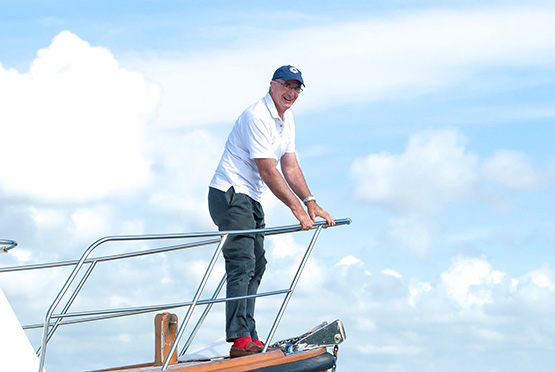 The Stag at Bay? Anthony O’leary sniffs the breeze last weekend, in charge of racing in the CH Marine Autumn league. This weekend he defends his All-Ireland title in Dun Laoghaire. Photo: Robert Bateman
The Stag at Bay? Anthony O’leary sniffs the breeze last weekend, in charge of racing in the CH Marine Autumn league. This weekend he defends his All-Ireland title in Dun Laoghaire. Photo: Robert Bateman
 Sailing should be fun, and run with courtesy – invitation to enjoyable racing, as displayed last weekend in Cork on Anthony O’Leary’s Committee Boat. Photo: Robert Bateman
Sailing should be fun, and run with courtesy – invitation to enjoyable racing, as displayed last weekend in Cork on Anthony O’Leary’s Committee Boat. Photo: Robert Bateman
But what those pioneering performance dinghy racers in 1946 can scarcely have imagined was that, 69 years later, no less than a quarter of the coveted places in the All-Ireland Championship lineup of 16 sailing stars would be going to helms who have qualified through winning their classes within the Annual National Championship of a thirteen-year-old all-Ireland body known as the Irish Cruiser-Racing Association.
And if you then further informed those great men and women of 1946 that those titles were all won in an absolute humdinger of a four-day big-fleet national championship staged in the thriving sailing centre and Irish gourmet capital of Kinsale, they’d have doubted your sanity. For in the late 1940s, Kinsale had slipped almost totally under the national sailing radar, while the town generally was showing such signs of terminal decline that there was little enough in the way of resources to put any food on any table, let alone think in terms of destination restaurants.
So in tracing the history of this uniquely Irish championship (for it long pre-dates the Endeavour Trophy in England), we have a convenient structure to hold together a manageable narrative of the story of Irish sailboat racing since the end of World War II. Add in the listings of the Irish Cruising Club trophies since the first one was instituted in 1931, then cross-reference this info with such records as the winners of the Round Ireland race and the Dun Laoghaire to Dingle Race, beef it all up with the winners of the national championship of the largest dinghy and inshore keelboat classes, and a comprehensible narrative of our national sailing history emerges.
 The veteran X332 Equinox (Ross McDonald) continues to be a force in Irish cruiser-racing, and by winning her class in the ICRA Nationals in Kinsale at the end of June, Equinox is represented in the All Irelands this weekend by helmsman Simon Rattigan. Photo: W M Nixon
The veteran X332 Equinox (Ross McDonald) continues to be a force in Irish cruiser-racing, and by winning her class in the ICRA Nationals in Kinsale at the end of June, Equinox is represented in the All Irelands this weekend by helmsman Simon Rattigan. Photo: W M Nixon
It’s far from perfect, but it’s a defining picture nevertheless, even if it lacks the inside story of the clubs. Be that as it may, in looking at it properly, we get a greater realization that the All-Ireland Helmsman’s Championship (or whatever you’re having yourself) is something very important, something to be cherished and nurtured from year to year.
Of course I’m not suggesting that we should all be out in Dublin Bay today and tomorrow on spectator boats, avidly watching every twist and turn as eight identical boats race their hearts out with a variety of helms calling the shots. Unless you’re in a particular helmsperson’s fan club, it’s really rather boring to watch from end to end, or at least until the conclusion of each stage and then the final races.
This is very much a sport for the “edited highlights”. The reality is that no matter how they try to jazz it up, sailing is primarily of interest only to those actively taking part, or directly engaged in staging each event. When great efforts are made to make it exciting for casual spectators, it costs several mints and results in rich people and highly-resourced teams engaged in costly and often unseemly battles to which genuine sporting sailors cannot really relate at all.
But with its exclusion of Olympic and some High Performance squad members, the All-Ireland in its current form is the quintessence of Irish local and national sailing. It’s almost compulsive for its participants, it provides an extra interest for their supportive clubmates, and in its pleasantly low key way it’s a genuine expression of real Irish sailing, the sailing of L’Irlande profonde.
So of course we agree that it might be more interesting for the bright young people if it was raced in something more trendy like the RS400s if they could find sufficient owners to risk their boats in this particular bear pit. And yes indeed, the ISA Discussion Paper and Helmsmans Guidelines of 2012 did indeed hope that within three years, the All Ireland would be staged in dinghies.
But we have to live in the real world. Sailing really is a sport for life, and some of our best sailors are truly seniors who would be disadvantaged if it was raced in a boat making too many demands on sheer athleticism, for which the unattainable Olympic Finn would be the only true answer.
But in any case, if you watch J/80s racing in a breeze, there’s no doubting the advantage a bit of athletic ability confers, yet the cunning seniors can overcome their lack of suppleness and agility with sheer sailing genius.
 While they may be keelboats, in a breeze the J/80s will sail better with some athleticism, as displayed here by Ben Duncan (second left) as he sweeps toward the finish and victory in the 2013 All Irelands at Howth. Photo: Aidan Tarbett
While they may be keelboats, in a breeze the J/80s will sail better with some athleticism, as displayed here by Ben Duncan (second left) as he sweeps toward the finish and victory in the 2013 All Irelands at Howth. Photo: Aidan Tarbett
 Yet a spot of sailing genius can offset the adverse effects of advancing years – Anthony O’Leary (right) with Dylan Gannon (left) and Dan O’Grady after snatching victory at the last minute in 2014. Photo: Jonathan Wormald.
Yet a spot of sailing genius can offset the adverse effects of advancing years – Anthony O’Leary (right) with Dylan Gannon (left) and Dan O’Grady after snatching victory at the last minute in 2014. Photo: Jonathan Wormald.
But another reality we have to accept is that Ireland is only just crawling out of the Great Recession. And in that recession, it was the enduring competitiveness of ageing cruiser-racers and the sporting attitude of their owners which kept the national sailing show on the road. Your dyed-in-the-wool dinghy sailor may sneer at the constrictions of seaborn truck-racing. But young sailors who were realists very quickly grasped that if they wanted to get regular sailing with good competition as the Irish economy went into free fall, then they had to hone their skills in making boats with lids, crewed by tough old birds most emphatically not in the first flush of youth, sail very well indeed.
Thus in providing a way for impecunious young people to keep sailing through the recession, ICRA performs a great service for Irish sailing. And the productive interaction between young and old in the ICRA fleets, further enlivened by their different sailing backgrounds, has resulted in a vibrant new type of sailing community where it is regarded as healthily normal to be able to move between dinghies and keelboats and back again.
The final lineup of entries is a remarkable overview of the current Irish racing scene, and if you wonder why the winner of the GP14 British Opens 2015, Shane McCarthy of Greystones, is not representing the GP 14s, the word is he’s unavailable, so his place is taken by Niall Henry of Sligo.
2014 Champion Anthony O'Leary, RCYC
RS400 Alex Barry, Monkstown Bay SC
GP14 Niall Henry ,Sligo Yacht Club
Shannon OD Frank Browne, Lough Ree YC
Flying Fifteen David Gorman, National YC
Squib Fergus O'Kelly, Howth YC
ICRA 1 Roy Darrer, Waterford Sailing Club
Mermaid Patrick, Dillon Rush SC
Laser Std Ronan Cull, Howth YC
SB20 Michael O'Connor, Royal St.George YC
IDRA14 Alan Henry, Sutton DC
RS200 Frank O'Rourke, Greystones SC
ICRA 2 Simon Rattigan, Howth YC
ICRA 4 Cillian Dickson, Howth YC
Ruffian Chris Helme, Royal St.George YC
As a three-person boat with a semi-sportsboat performance, the J/80 is a reasonable compromise between dinghies and keelboats, and the class has the reputation of being fun to sail, which is exactly what’s needed here.
The Sailing Olympics and the ISAF Worlds may be terribly important events for sailing in the international context, but nobody would claim they’re fun events. Equally, though, you wouldn’t dream of suggesting the All-Ireland is no more than a fun event. But it strikes that neat balance between tough sport and sailing enjoyment to make it quite a good expression of the true Irish amateur sailing scene.
Inevitably from time to time it produces a champion whose sailing abilities are so exceptional that it would amount to a betrayal of their personal potential for them not to go professional in some way or other. But fortunately sailing is such a diverse world that two of the outstanding winners of the Helmsman’s Championships of Ireland have managed to make their fulfilled careers as top level professional sailors without losing that magic sense of fun and enjoyment, even though in both cases it has involved leaving Ireland.
Their wins were gained in the classic early Irish Yachting Association scenario of a one design class which functioned on a local basis being able to provide enough reasonably-matched boats to be used for the Helmsman’s, and the three I best remember were when Gordon Maguire won in 1982 on Lough Derg racing Shannon One Designs, then in the 1970s Harold Cudmore won on Lough Neagh racing Flying Fifteens, and in 1970 itself, a very young Robert Dix was winner racing National 18s at Crosshaven.
Gordon Maguire was the classic case of a talented sailor having to get out of Ireland to fulfill himself. His win in 1982 in breezy conditions at Dromineer in Shannon One Designs, with Dave Cummins of Sutton on the mainsheet, was sport at its best, though I doubt that some of the old SODs were ever the better again after the hard driving they received.
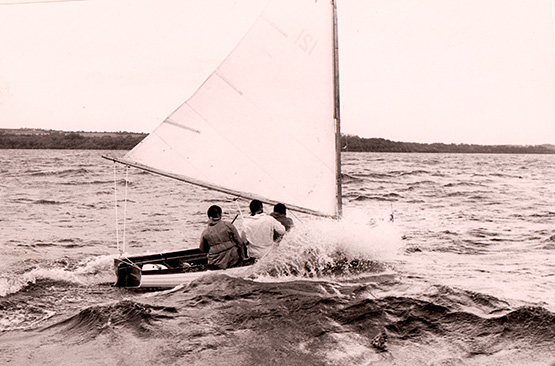 Driving force. Gordon Maguire going indecently fast for a Shannon One Design, on his way to winning the Helmsmans Championship of Ireland at Dromineer in 1982. Photo: W M Nixon
Driving force. Gordon Maguire going indecently fast for a Shannon One Design, on his way to winning the Helmsmans Championship of Ireland at Dromineer in 1982. Photo: W M Nixon
Then Gordon spread his wings, and won the Irish Windsurfer Nationals in 1984 - a great year for the Maguires, as his father Neville (himself a winner of the Helmsmans Championship five times) won the ISORA Championship with his Club Shamrock Demelza the same weekend.
But Gordon needed a larger canvas to demonstrate his talents, and in 1991 he was a member of the Irish Southern Cross team in Australia, a series which culminated in the Sydney-Hobart Race. The boat which Maguire was sailing was knocked out in a collision with another boat (it was the other boat’s fault), but Maguire found a new berth as lead helm on the boat Harold Cudmore was skippering for the Hobart Race, and they won that overall.
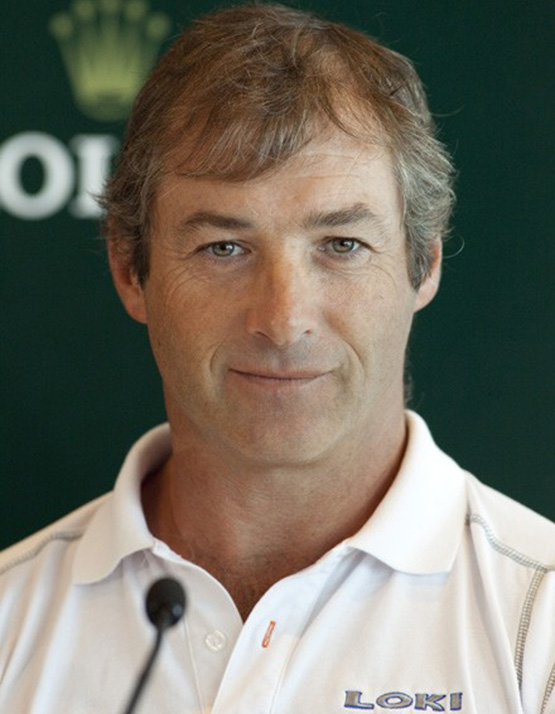 A man fulfilled, Gordon Maguire at the beginning of his hugely successful linkup with Stephen Ainsworth’s RP 63 Loki
A man fulfilled, Gordon Maguire at the beginning of his hugely successful linkup with Stephen Ainsworth’s RP 63 Loki
And Gordon Magure realized that for his talents, Australia was the place to be. More than twenty years later, he was to get his second Hobart Race overall win in command of Stephen Ainsworth’s RP 63 Loki, and here indeed was a man fulfilled, revelling in a chosen career which would have been unimaginable in Ireland.
Harold Cudmore had gone professional as best he could in 1974, but it was often a lonely and frustrating road in Europe. However, his win of the Half Ton Worlds in Trieste in the Ron Holland-designed, Killian Bushe-built Silver Shamrock in 1976 put his name up in lights, and he has been there ever since, renowned for his ability to make any boat perform to her best. It has been said of him when racing the 19 Metre Mariquita in the lightest conditions, that you could feel him getting an extra ounce of speed out of this big and demanding gaff-rigged classic seemingly by sheer silent will power.
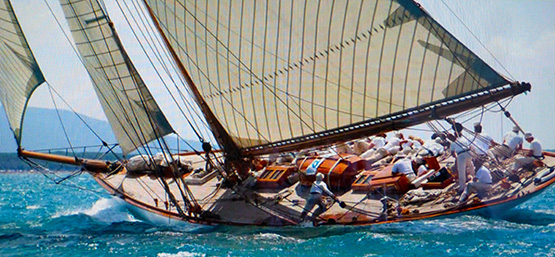
The restored 19 Metre Mariquita is a demanding beast to sail in any conditions…

...but in light airs, Harold Cudmore (standing centre) seems to be able to get her to outsail larger craft by sheer will-power.
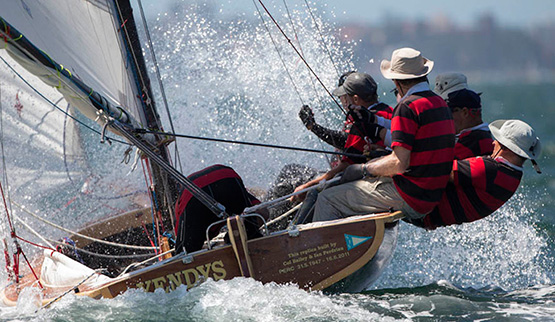 A different scene altogether, but still great sport – Harold Cudmore racing the classic Sydney Harbour 18-footer Yendys
A different scene altogether, but still great sport – Harold Cudmore racing the classic Sydney Harbour 18-footer Yendys
But as for Robert Dix’s fabulous win in 1970, while he went on to represent Ireland in the 1976 Olympics in Canada, he has remained a top amateur sailor who is also resolutely grounded in Irish business life (albeit at a rather stratospheric level). But then it could be argued that nothing could ever be better than winning the Helmsmans Championship of Ireland against the cream of Irish sailng when you’re just 17 years old, and doing it all at the mother club, the Royal Cork, as it celebrated its Quarter Millenium.
It was exactly 44 years ago, the weekend of October 3rd-4th 1970, and for Robert Dix it was a family thing, as his brother-in-law Richard Burrows was Number 2 in the three-man setup. They were on a roll, and how. The manner in which things were going their way was shown in an early race when they were in a tacking duel with Harold Cudmore. Coming to the weather mark, Cudmore crossed them on port, but the Dix team had read it to such perfection that by the time he had tacked, they’d shot through the gap with inches to spare and Cudmore couldn’t catch them thereafter.

Decisive moment in the 1970 Helmsman’s Championship. At the weather mark, Harold Cudmore on port is just able to cross Robert Dix on starboard………Photo W M Nixon
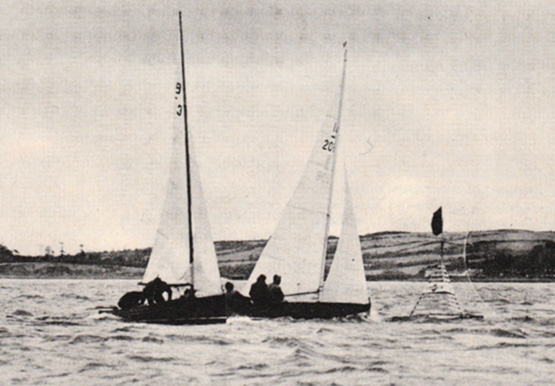 ……but Dix is able to shoot through the gap as Cudmore tacks…..Photo: W M Nixon
……but Dix is able to shoot through the gap as Cudmore tacks…..Photo: W M Nixon
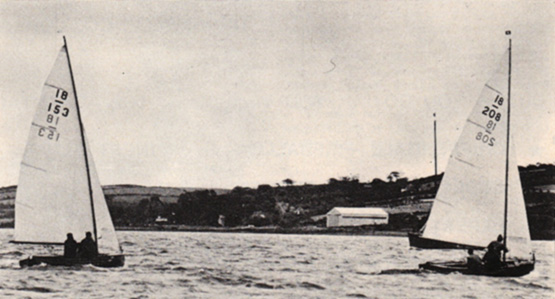 …..and is on his way to a win which will count well towards his overall victory over Cudmore by 0.4 points. Photo: W M Nixon
…..and is on his way to a win which will count well towards his overall victory over Cudmore by 0.4 points. Photo: W M Nixon
Admittedly both Harold Cudmore and the equally-renowned Somers Payne had gear problems, but even allowing for that, the 17-year-old Robert Dix from Malahide was the star of the show, and the final points of Robert Dix 9.5 and Harold Cudmore 9.9 for the 1970 Helmsman’s Championship of Ireland says it all, and it says it as clearly now as it did then.
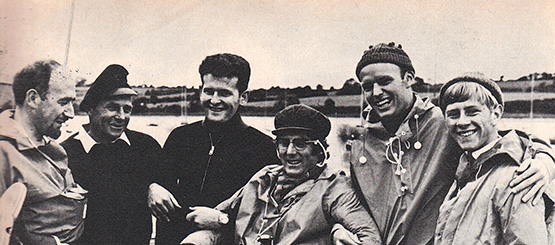
The six finalists in the 1970 Helmsman’s Championship were (left to right) Michael O’Rahilly Dun Laoghaire), Somers Payne (Cork), Harold Cudmore (Cork), Owen Delany (Dun Laoghaire), Maurice Butler (Ballyholme, champion 1969) and Robert Dix (Malahide), at 17 the youngest title holder ever. Photo: W M Nixon
ICRA Plans 2016 Commodores Cup Defence at Portlaoise Meeting
This week's Irish Cruiser Racer Association (ICRA) meeting in Portlaoise heard a full agenda that included plans for the defence of its Commodore's Cup title. Putting a team together to retain the Cup will be no easy feat especially with this week's news Great Britain intends to send four strong teams to Cowes in July 2016.
So far word from the Kildare meet suggests victorious Royal Cork team Captain Anthony O'Leary will very much be part of the title defence but, as previously reported, the acclaimed shore team of Fintan Cairns and Barry Rose will step down.
Quokka, the UK owned 43–footer that filled the middle slot for Ireland in 2014, appears to be still connected with skipper Michael Boyd but she is also for sale so it is unclear if she will be available next summer.
A small boat is now required for the 2016 team and a JPK 10.80 (a sistership to this year's Fastnet winner) is heading for Dublin Bay next year and although selectors have identified her as a key candidate it does not mean the new owner will necessarily put the boat forward. Afloat.ie understands other options for the small boat are also being considered, including a link up with a UK based JPK 10.80.
Meanwhile, selection is open for the Great Britain team, with the RYA planning to send four teams of three boats to represent Great Britain.
The RYA is seeking expressions of interest from owners and teams who would like to compete for Great Britain at the 2016 event. Teams comprise of three boats within the IRC rating 1.0 - 1.230. One team will be nominated by RYA Scotland and the other three by the RYA.
The seven day event consists of two offshore events within the English Channel and a number of inshore events in the Solent, pitting three-boat teams against one another to win overall team points.
The selection process will begin in the New Year with a number of events defined as selection regattas.
The completed RYA selection Trials Entry Form and proposed crew lists for the Selections Trials of the GBR teams should be delivered to the RYA before 1700 on Friday 29 January, together with the entry fee. Entries after this date will be accepted up to Friday 25 March subject to a late entry fee.
Royal Thames Win New York Invitational Cup, Royal Cork Finish Seventh
Anthony O'Leary's bid to win the New York Invitational Cup for Royal Cork Yacht Club will have to wait for another edition after Britain's Royal Thames YC lifted the Cup in Newport, Rhode Island yesterday. The sole Irish entry finished seventh.
The morning air reverberated with the sound of cannon fire and boat horns as the international fleet, battle flags flying, paraded around Newport harbor and past the main dock of the New York Yacht Club where supporters were gathered to cheer them on for the final day of the 2015 Rolex New York Yacht Club Invitational Cup.
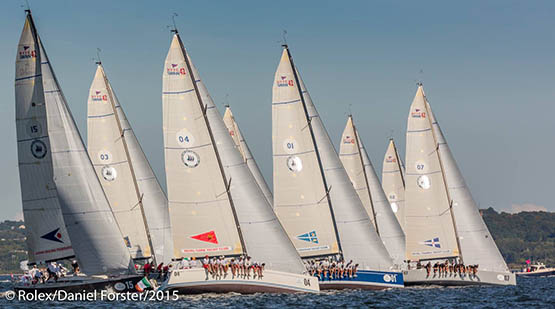
This traditional sendoff for the competitors is just one of the many details that make this event so special. Over four editions, 21 countries have gone head-to-head on the water and then made lasting friendships during social gatherings at Harbour Court, New York Yacht Club’s iconic waterfront clubhouse in Newport. As with the heritage of the sport, woven into the very fabric of this event is the historic partnership of Rolex and New York Yacht Club, which was forged in the 1950s. Through this enduring association, one of yachting’s greatest traditions was established with a winning sailor being presented a specially-engraved Rolex timepiece – the ultimate symbol for achieving excellence.
Out on the water, the fleet was sent up Narragansett Bay for the second consecutive day, where racing was held in an eight knot south-southwesterly breeze. The team representing the oldest yacht club in the world, London’s Royal Thames Yacht Club, was in the most perilous position of the 17 competing teams. Having been in the lead, or tied for the lead, through the entire series, it was their regatta to win – or lose. In the first race of the day, an eighth-place finish put their nine-point cushion under pressure. With their closest competitor in the standings – Marblehead’s Eastern Yacht Club – finishing fourth, the gap shrunk to five points.

“We didn’t make it very easy for ourselves throughout the day,” said John Greenland, skipper of the Royal Thames Yacht Club team. “At one point in the first race we almost sailed ourselves into a really comfortable position. Instead it turned inside out. But that’s how the fleet has been all week. You just have to take each race as it comes.”
Greenland said the team had a conversation to make sure they were in the right mindset going into the last race. They crossed the line 10th, with Eastern Yacht Club following in 12th; the Brits securing the win 71 points to Eastern’s 78. “The overall level has absolutely improved,” said an elated Greenland. “The competition is demonstrated in the results. There are some seriously good sailors in these boats who are struggling to get into the top five. It’s a great conclusion to years of preparation… everyone is over the moon.”
The New York Yacht Club’s team, led by skipper Paul Zabetakis, concluded the series second overall after finishes of 3-6 were added to their score line for 77 points. “We were third on the first day then we dropped to ninth; we had a couple of bad races,” said Zabetakis. “We kept telling ourselves we could do it. Yesterday we went from ninth to fourth and then today it was a matter of sailing our own race. We felt like we did a great job.”
The only team new to the 2015 Rolex New York Invitational Cup, Australia’s Middle Harbour Yacht Club, not only met their goal for the regatta, they exceeded it. Hoping to finish in the top-five, they were fourth overall with 81 points after finishes of 7-2 on the final day of racing. Just one point behind was the Japan Sailing Federation, after placing 2-5 today.
Guido Belgiorno-Nettis, skipper of the Middle Harbour Yacht Club team was very happy with team’s final position in their first appearance at the event. “We’re a bit hard on ourselves,” said the 2011 Rolex Farr 40 World Champion. “Putting the spinnaker in the water on the penultimate day of the competition was not a very smart tactical move. It set a bad precedent; we were about fourth [at that point] and then we finished 11th in that race. If you’re in fourth place around the top mark you have half a chance of defending that position and not getting caught up with the fleet; but once you drop back its very hard. We came second today and once we managed to get out of the pack we just kept extending.”
Zabetakis, who has been sailing since his mid-20s, but has raced the Mumm 36 and Farr 40 Worlds, and Key West Race Week, in addition to campaigning his Swan 42, summed up the uniqueness of the event: “This regatta has no equal. The other races [in which I’ve sailed], there were always pros involved. I think it’s a phenomenal tribute to New York Yacht Club who put this together, and these amateur teams that come together to do this. It’s the most competitive racing I’ve ever done.”




























